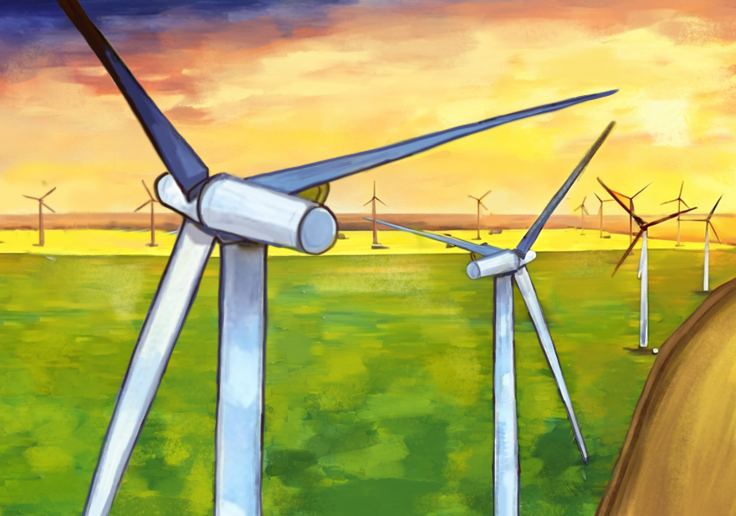
As we face an ever-growing climate crisis, finding reliable sources of renewable energy has become critical to our society’s survival. Renewable energy, like solar power from the sun or hydropower from water, is energy that never depletes. Compared to traditional energy sources like coal and natural gas, renewable energy is far more sustainable and we can harness it without the fear of running out.
One of the most notable sources of renewable energy is wind power. Wind is generated by the uneven heating of the Earth’s surface by the sun, creating airflow in the atmosphere. This energy can be captured through specialized devices and converted into electricity.
One of the most common sources of wind energy is the wind turbine. Essentially, wind blows over the blades of a turbine, designed to generate lift. This causes the blades to spin, turning a shaft connected to an electric generator – producing electricity.
But how did we start harnessing wind for energy? Dating back to 7th and 9th century Iran, early windmills were used for mechanical tasks like grinding grain and pumping water. With their vertical axes and cloth-covered sails, these windmills were some of the first devices designed to capture wind energy.
The realization that wind could be a viable source of electricity led to further innovations. In the U.S., inventor Charles Brush built a wind turbine to power his mansion in Ohio. Soon after, wind turbines spread across Denmark, which would later become a global leader in wind power technology. By 1980, the world’s first wind farm—a 20-turbine installation—was brought online in New Hampshire, marking a significant milestone in the shift toward renewable energy.
Last week, I had the opportunity to visit one of the largest and most iconic wind farms in the U.S., the San Gorgonio Pass Wind Farm near Palm Springs, California. With more than 3,000 wind turbines stretching across the valley, the farm harnesses the powerful winds that sweep through the San Gorgonio Pass, a natural wind funnel between the San Bernardino and San Jacinto Mountains. These turbines now tower up to 300 feet high, dwarfing the early 10-meter prototypes from the past.
San Gorgonio Pass Wind Farm is a vital part of California’s renewable energy strategy, as it generates around 615 megawatts of energy, enough to power hundreds of thousands of our homes. Not only is it one of the oldest wind farms in the U.S., but it’s also a symbol of how wind energy technology has evolved, mixing older turbines with state-of-the-art models.
Nationally, wind turbines currently generate about 10% of the electricity in the U.S., with the highest concentrations in the central and midwestern regions. Just one modern turbine can generate over 6 million kilowatt-hours of electricity annually—enough to power around 1,500 households. Across the country, there are now more than 70,000 wind turbines.
Globally, wind power continues to grow, with over 400,000 turbines worldwide. Countries like Norway, China, and Denmark have been leading the charge, making significant strides in wind energy production and playing a crucial role in the fight against climate change.
As we continue to innovate and expand our wind energy infrastructure, this renewable resource plays a crucial role in combating climate change and reducing our reliance on fossil fuels. The impressive turbines at places like San Gorgonio Pass not only generate substantial electricity but also symbolize the potential of wind power to meet our energy needs sustainably. The ongoing advancements in wind technology and the increasing global adoption of this clean energy source inspire hope for a future where renewable energy drives us toward a cleaner, more resilient world.
Works Cited
U.S. Energy Information Administration. “Where Wind Power Is Harnessed.” Energy Explained, www.eia.gov/energyexplained/wind/where-wind-power-is-harnessed.php. Accessed 18 Oct. 2024.
U.S. Department of Energy. “How Do Wind Turbines Work?” Office of Energy Efficiency and Renewable Energy, www.energy.gov/eere/wind/how-do-wind-turbines-work. Accessed 18 Oct. 2024.
Renewable Energy World. “History of Wind Turbines.” www.renewableenergyworld.com/wind-power/history-of-wind-turbines/. Accessed 18 Oct. 2024.
International Energy Agency. “Wind.” IEA Energy System, www.iea.org/energy-system/renewables/wind. Accessed 18 Oct. 2024.
Windmill Tours. “The Disappearing Windmills.” www.windmilltours.com/blog/disappearing-windmills/. Accessed 18 Oct. 2024.
The views and opinions expressed are those of the authors and do not necessarily reflect nor represent the Earth Chronicles and its editorial board.




